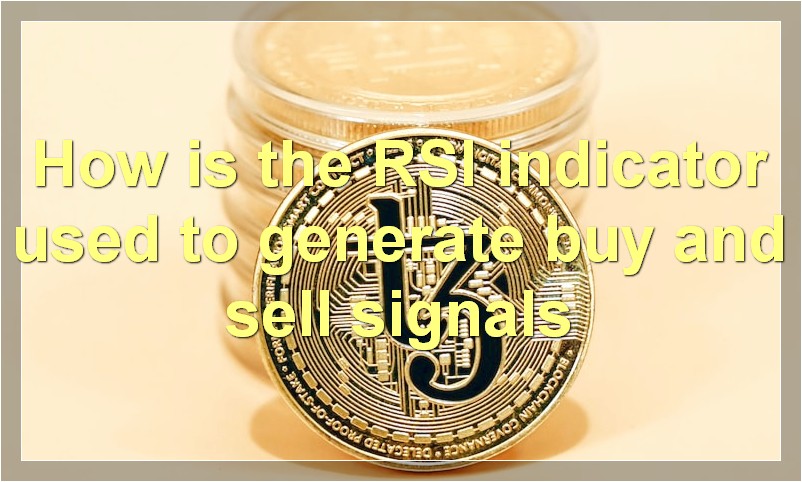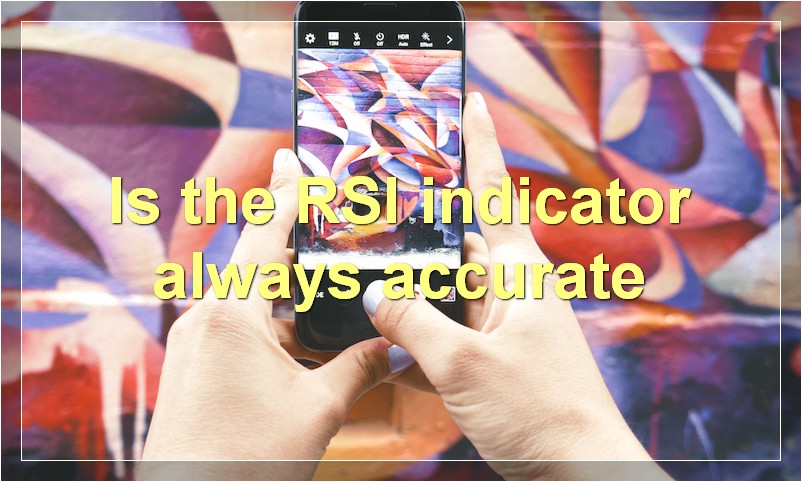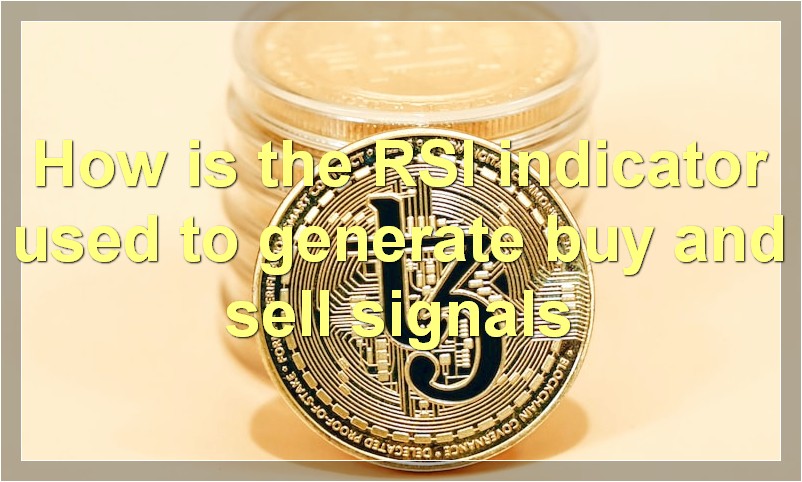If you’re a day trader, then you know that every little advantage can make a big difference. That’s why you need to know about the RSI indicator.
What is the RSI indicator
The RSI indicator is a technical analysis tool that measures the strength of a stock’s recent price performance.
The RSI is calculated using a stock’s closing price over a given period of time. The indicator ranges from 0 to 100, with readings below 30 indicating an oversold condition and readings above 70 indicating an overbought condition.
The RSI is a popular tool among traders and investors alike, as it can provide valuable insights into a stock’s momentum.
How is the RSI indicator used to generate buy and sell signals

The RSI indicator is used to generate buy and sell signals by measuring the relative strength of a security’s recent price performance. The RSI is calculated using a simple mathematical formula that compares the magnitude of a security’s recent gains to the magnitude of its recent losses.
The RSI can be used to generate buy signals when the indicator moves above 50 and sell signals when it moves below 50. However, there are a number of different ways that traders can use the RSI to generate signals, and the interpretation of the indicator can vary depending on the time frame that is being used.
Some traders may choose to use the RSI as a standalone indicator, while others may use it in conjunction with other technical indicators or chart patterns. No matter how it is used, the RSI can be a valuable tool for identifying market reversals and generating trade signals.
What are some common misconceptions about the RSI indicator
The RSI indicator is a momentum oscillator that measures the speed and change of price movements. The RSI indicator is used to identify overbought and oversold conditions in the market.
One common misconception about the RSI indicator is that it is a lagging indicator. This is not the case, as the RSI indicator is a leading indicator. Another common misconception about the RSI indicator is that it is only useful for identifying overbought and oversold conditions. This is also not the case, as the RSI indicator can be used to identify bullish and bearish divergences, as well as to generate signals for buy and sell orders.
How can traders use the RSI indicator to filter trading signals
The RSI indicator is a popular tool among traders and can be used to filter trading signals. The indicator can be used to identify overbought and oversold conditions, as well as to spot divergences. The RSI can also be used to confirm other trading signals, such as breakouts and trend reversals.
What are some common mistakes that traders make when using the RSI indicator
The Relative Strength Index (RSI) is a momentum oscillator that measures the speed and change of price movements. The RSI oscillates between zero and 100. Traders generally use the RSI to identify overbought and oversold conditions in the market, as well as potential reversals.
One common mistake that traders make when using the RSI is failing to identify the underlying trend. The RSI can remain overbought or oversold for extended periods of time in a strong trend. As a result, it is important to identify the direction of the underlying trend before using the RSI as a trade signal.
Another mistake that traders make is using the RSI as a standalone indicator. The RSI should be used in conjunction with other technical indicators or analysis techniques to confirm trade signals. For example, a trader might look for bullish divergences on the RSI chart (where price makes a lower low but the RSI makes a higher low) in an uptrending market.
Finally, many traders mistakenly believe that all buy signals occur when the RSI moves above 50 (or all sell signals occur when the RSI moves below 50). However, this is not always the case. The level at which the RSI generates buy or sell signals will depend on the timeframe that is being used. For example, a trader looking at a daily chart might wait for the RSI to move above 70 before entering a long position, while a trader looking at a four-hour chart might enter a long position when the RSI moves above 50.
Is the RSI indicator always accurate

The RSI indicator is a very popular technical indicator that is used by traders to gauge the strength of a given market. However, many traders believe that the RSI indicator is not always accurate and can sometimes give false signals. In this blog post, we will discuss whether or not the RSI indicator is always accurate and if it can be trusted.
The RSI indicator is based on the price action of a given market and uses a mathematical formula to calculate the strength of the market. The indicator ranges from 0 to 100, with 0 being the weakest and 100 being the strongest. The general rule of thumb is that if the RSI indicator is above 70, the market is considered overbought and if it is below 30, the market is considered oversold.
However, many traders believe that the RSI indicator is not always accurate. One of the main reasons for this is because the indicator does not take into account other important factors such as volume. Additionally, the RSI indicator can often give false signals in choppy markets. As a result, many traders choose to use other technical indicators in conjunction with the RSI indicator to get a more accurate picture of the market.
Overall, the RSI indicator is a useful tool for traders but it is not always accurate. Traders should use other technical indicators in conjunction with the RSI indicator to get a more complete picture of the market.
How can traders use other technical indicators in conjunction with the RSI indicator to generate more reliable signals
The Relative Strength Index (RSI) is a popular technical indicator that traders use to find momentum in the market. The RSI can be used on its own to generate signals, but it is more reliable when used in conjunction with other technical indicators. In this essay, we will discuss how traders can use other technical indicators in conjunction with the RSI indicator to generate more reliable signals.
One technical indicator that can be used in conjunction with the RSI is the moving average convergence divergence (MACD). The MACD is a trend-following indicator that can help traders identify when a trend is starting or reversing. The MACD is calculated by subtracting the 26-period exponential moving average (EMA) from the 12-period EMA. When the MACD line crosses above the signal line, it is a bullish signal, and when it crosses below the signal line, it is a bearish signal.
Another technical indicator that can be used in conjunction with the RSI is the stochastic oscillator. The stochastic oscillator is a momentum indicator that measures whether a stock is overbought or oversold. The stochastic oscillator is calculated by subtracting the stock’s low for the period from its current close, and then dividing this number by the high-low range for the period. A reading of 0 indicates that the stock is at its low for the period, and a reading of 100 indicates that the stock is at its high for the period.
When using the RSI in conjunction with other technical indicators, it is important to remember that no single indicator is perfect. Each indicator has its own strengths and weaknesses, and no indicator should be used in isolation. Instead, traders should use a combination of indicators to generate more reliable signals.
What time frames are best suited for using the RSI indicator
There is no definitive answer to this question as different traders will have different opinions. However, some general guidelines that may be useful are as follows:
-The RSI indicator can be used on any time frame, but shorter time frames will produce more signals which may not all be accurate. As such, it is often best to use the RSI on longer time frames such as the 4-hour or daily chart.
-The RSI indicator can be used in conjunction with other technical indicators or price action analysis to confirm signals. For example, a bearish signal on the RSI on the 4-hour chart could be confirmed by a bearish candlestick pattern on the same chart.
-It is important to remember that the RSI is a momentum indicator and as such, it works best in trending markets. In non-trending or choppy market conditions, the RSI may produce false signals.
How does the RSI indicator perform in different market conditions
The RSI indicator is a popular technical indicator that is used by traders to measure the strength of a market. The indicator can be used in different market conditions, but it is most effective in markets that are trending. In markets that are range-bound or choppy, the RSI indicator can give false signals.
Are there any drawbacks to using the RSI indicator
The Relative Strength Index (RSI) is a widely used technical indicator that measures the magnitude of recent price changes to evaluate overbought or oversold conditions in the price of a stock or other asset.
While the RSI can be a helpful tool for traders, there are also some drawbacks to using this indicator.
First, the RSI only looks at price changes, and does not take into account other important factors such as volume or open interest. This can lead to false signals.
Second, the RSI is a lagging indicator, meaning it will only tell you what has happened in the past, and not what is happening right now. This can lead to missed opportunities.
Finally, the RSI is a highly volatile indicator, and can give false signals during periods of high market volatility.
Despite these drawbacks, the RSI is still a popular indicator among traders due to its simplicity and ability to provide clear buy and sell signals.

